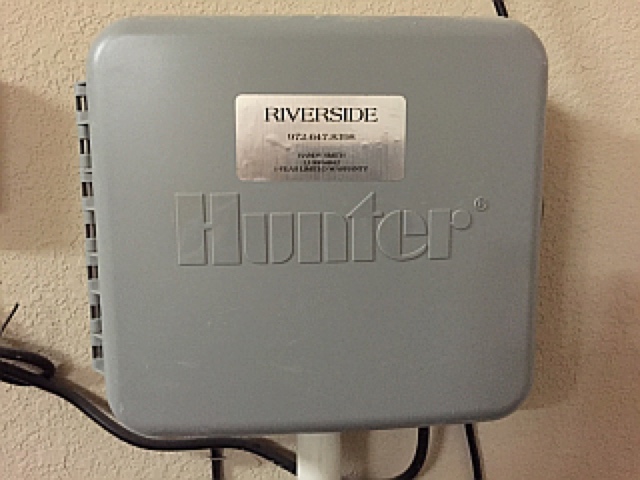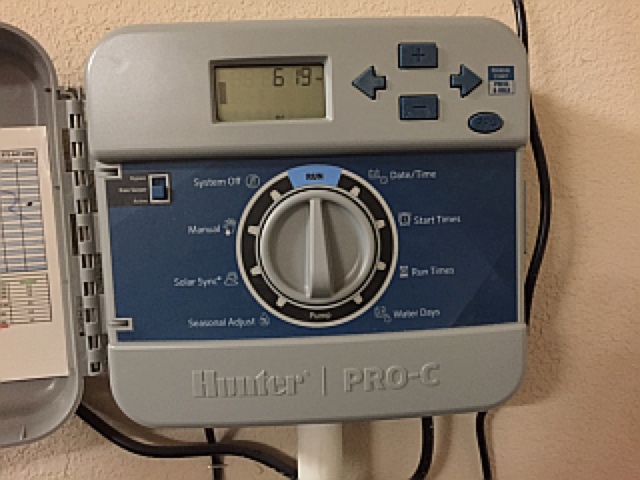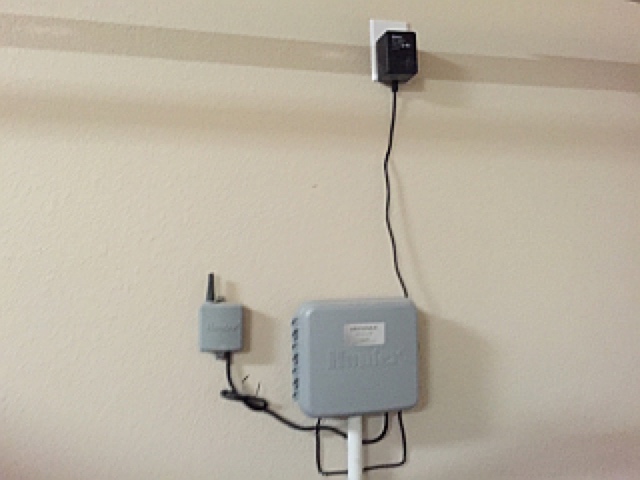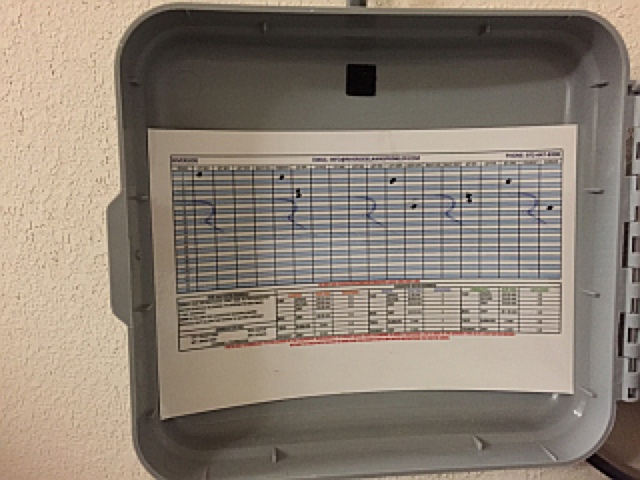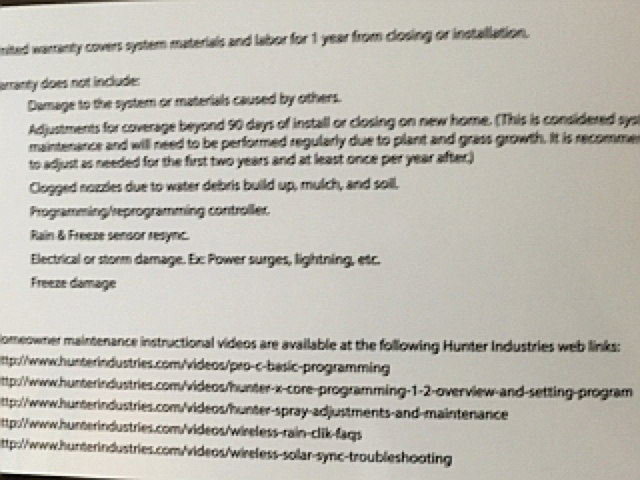Latest Update: Sunday, 16 October, 2016
• Current Sprinkler Schedules
• Original Sprinkler installation
• Sprinkler Schedule and Location Map
• Manuals, Models, Serial Numbers
• Irrigation in Roanoke
• Watering by hand-held hose, drip irrigation or soaker hose is
allowed at any time. Residents are encouraged to limit such
watering to a maximum of 2 hours per day.
• Stage 1 limits outdoor watering with an irrigation system or
hose-end sprinkler to a maximum of 2 assigned days per week
for all customers
• The twice-a-week watering schedule is in effect year-round for the
City of Roanoke
• Residential customers whose addresses end in odd numbers
(1, 3, 5, 7 or 9) are permitted to water lawn and landscapes
only on Sundays and Thursdays.
• The time of day restriction, which prohibits outdoor watering
with sprinklers between the hours of 10 a.m. and 6 p.m.,
continues to be in effect. [Water 6P to 10A.]
• Roanoke ARTICLE 11.1400 - WATER CONSERVATION
• Walk-through with Homeowner, FortWorthTexas.gov
• Fort Worth Water Fort Worth Water Dept
Drought Contingency & Emergency Water Management Plan for
Retail and Wholesale Water Customers
[NOTE: Roanoke, who supplies water to Highlands Glen, is a wholesale
water customer of Fort Worth.]
Actions Available for Stage 1
All Water Users: Initiate mandatory restrictions to prohibit
non-essential water use as follows:
…
• Prohibit using water in such a manner as to allow runoff
or other waste, including:
• failure to repair a controllable leak, including a
broken sprinkler head, a leaking valve, leaking or
broken pipes, or a leaking faucet;
• operating a permanently installed irrigation system
with: (a) a broken head; (b) a head that is out of
adjustment and the arc of the spray head is over a
street or parking lot; or (c) a head that is misting
because of high water pressure; or
• during irrigation, allowing water to (a) to run off a
property and form a stream of water in a street for a
distance of 50 feet or greater; or (b) to pond in a street
or parking lot to a depth greater than one-quarter of
an inch.
• Allowing or causing an irrigation system or other lawn
watering device to operate during any form of precipitation
or when temperatures are at or below 32 degrees Fahrenheit.
…
4.6 Procedures for Enforcing Mandatory Water Use Measures
Mandatory water use restrictions may be imposed in Stages 1,
2, and 3. These mandatory water use restrictions will be enforced
by warnings and penalties as follows:
• On the first violation, customers will be given a written warning
that they have violated the mandatory water use restriction.
• On the second and subsequent violations, citations may be
issued to customers, with minimum and maximum fines
established by ordinance.
• After three violations have occurred, the utility may cut
off water service to the customer.
• Irrigation in North Texas
• Watering & Conservation Guide, Texas SmartScape.com
• Deep infrequent watering creates deep roots.
• Whenever possible, water between 8 p.m. and 10 a.m.;
early morning is best to avoid evaporation.
• Water every 5 to 7 days in the summer and ever 15 to 20
in the winter.
• Leave grass clippings on the lawn to help maintain moisture.
• St. Augustine grass usually needs water every 5-7 days.
This promotes good root growth and should provide the amount
of water the plants require.
• Bermuda grass can go 7-8 days between watering if
maintained properly.
• Water trees separately by placing a soaker hose under the
outer ring of branches and let the hose drip for several hours,
as needed.
• Efficient Use of Water in the Garden and Landscape,
Texas A&M AgriLife
• Guidelines for Watering Texas Lawns,
Riverside Irrigation And Landscaping
The Dallas Morning News, 01 February 2012
• Sod Grass and Drip Irrigation
• The North Texas Municipal Water District > WaterIQ
The key to watering lawns is to apply the water only when
needed while creating a deep, well-rooted lawn that efficiently
uses water stored in the soil. Due to clay soils in North Texas, Texas
A&M AgriLife Research and Extension Service recommends using
the Cycle-Soak Method for watering lawns, which provides better
water absorption and less runoff.
Drip irrigation systems are very efficient (use up to 60% less water)
at supplying water to smaller areas of a landscape. These systems
are based upon the fact that plant roots stay in an area that has
sufficient water. Drip irrigation places a small amount of water
(and, as an option, nutrients) close to the roots. Almost 95% of drip
irrigation water can reach a plant, while traditional automatic
sprinklers are much less efficient…Maintain a deep, infrequent
watering schedule. This approach is best for the overall health of the
lawn. It allows your grass to develop deep root systems, reduces
disease, helps insure good air movement down to the root system,
and conserves water. The most common warm season grasses for
our area St Augustine, Zoysia, and Bermuda all can benefit from this
watering approach
• Subsurface Drip Irrigation (SDI) for Turf, by Southwest Trees and
Turff, December 23, 2014
Sprinkler systems are the most commonly used irrigation systems for
turf-dominated landscapes despite their inefficiencies due to losses
from run-off, wind drift, and evaporation. Subsurface irrigation
systems, on the other hand are considered to irrigate more
efficiently as they apply water directly to the rootzone, thereby
avoiding problems such as overspray, runoff, and wind drift.
• Subsurface drip irrigation for bermudagrass with reclaimed water,
November 2004, American Society of Agricultural Engineers
The amount of water applied in the subsurface drip irrigated plots to
maintain acceptable visual quality was similar to that applied in the
sprinkler irrigated plots… Inspection of the emitters at the end of the
irrigation seasons found signs of root intrusion into the emitters,
which may pose a threat to the long-term use of subsurface drip
irrigation.
• Subsurface Drip Irrigation for Sports Turf, 2013
New Mexico State University,
No reduction in quality when turfgrasses were irrigated with potable
water from a subsurface drip system over several years. Conclusion
1. Subsurface drip irrigation can be used to irrigate turf efficiently,
2) also in combination with saline water,
3) is a viable alternative to traditional sprinkler systems if installed,
monitored, and maintained properly
• Subsurface Drip Irrigation, 1994, Center for Irrigation Technology
Research Report
As long as root intrusion can be avoided, subsurface drip irrigation
is potentially a very high efficiency system.
• Tall Fescue and Bermudagrass Establishment and Management
Using Subsurface Drip Irrigation (SDI) vs. Overhead Sprinkler
Irrigation (OSI), 2012, Univ. of CA, Division of Agriculture and
Natural Resources Subsurface drip irrigation systems irrigate
more efficiently because they apply water from emitters placed
within the rootzone. Advantages of SDI include the uninterrupted
use of the turf area during irrigation, energy savings as a result of
lower operating water pressure, no human
exposure to irrigation water, reduced disease pressure, and potential
water savings because irrigation is limited to the turf area and is not
affected by wind drift or evaporation. Arguments against the use of
SDI include high installation costs, difficulty in determining spacing
and depth of pipes or emitters, a perceived inability to establish turf f
rom seed or sod when using SDI, a perceived interference with
regular maintenance, and a perceived inability to leach salts.
